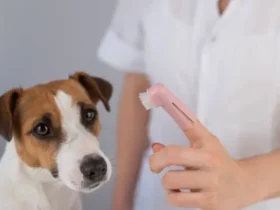Understanding and Cleaning Dog Tear Stains
Tear stains in dogs can be a common and concerning issue for pet owners. These unsightly marks often appear around the eyes and can be a source of discomfort for both dogs and their owners. Understanding the causes and learning how to properly clean and manage tear stains is crucial for maintaining your dog’s health and appearance. This guide will provide you with detailed information about dog tear stains, their causes, and effective cleaning methods.
What Are Tear Stains?
Tear stains are discolorations that appear around a dog’s eyes, typically as reddish-brown or rust-colored streaks on the fur. These stains are often more noticeable on light-colored or white dogs but can affect any breed. Tear staining occurs when tears overflow and come into contact with the fur, leading to a buildup of pigments and bacteria.
Causes of Tear Stains
Several factors can contribute to the development of tear stains in dogs. Understanding these causes can help you address the issue more effectively:
- Excessive Tear Production: Increased tear production, known as epiphora, can lead to tear staining. This may be due to various conditions, such as eye infections, allergies, or blocked tear ducts.
- Blocked Tear Ducts: Tear ducts that are blocked or obstructed can cause tears to overflow and accumulate around the eyes. This condition may require veterinary attention to address the underlying blockage.
- Infections: Bacterial or fungal infections can cause irritation and inflammation in the eye area, leading to excessive tearing and subsequent staining.
- Allergies: Allergies to food, environmental factors, or substances can cause eye irritation and increased tear production, resulting in tear stains.
- Genetics: Certain breeds, such as Poodles, Shih Tzus, and Maltese, are more prone to tear staining due to their facial structure and tear duct anatomy.
- Diet: An imbalanced diet or sensitivities to specific ingredients can contribute to tear staining. Low-quality food or certain additives may exacerbate the problem.
- Poor Hygiene: Lack of regular grooming and cleaning around the eyes can lead to the accumulation of debris and bacteria, worsening tear stains.
How to Clean Tear Stains
Cleaning tear stains involves a combination of proper hygiene practices and targeted treatments. Here’s a step-by-step guide to effectively clean and manage tear stains:
- Gather Supplies: You will need clean, soft cloths or cotton pads, a mild, pet-safe cleaning solution, and possibly specialized tear stain removers. Avoid using human products or harsh chemicals that can irritate your dog’s eyes.
- Use a Gentle Cleaning Solution: Choose a tear stain remover or a mild solution recommended by your veterinarian. Solutions containing natural ingredients like chamomile or aloe can be soothing for the sensitive eye area.
- Clean the Affected Area: Moisten a cloth or cotton pad with the cleaning solution. Gently wipe away the tear stains and any debris around your dog’s eyes. Be careful not to get the solution into your dog’s eyes.
- Dry the Area: After cleaning, use a dry cloth or cotton pad to gently pat the area around the eyes dry. This helps prevent further staining and keeps the area clean.
- Regular Grooming: Incorporate regular grooming into your dog’s routine. Brush the fur around the eyes to prevent tangles and remove any trapped debris.
- Monitor Tear Production: Keep an eye on your dog’s tear production and note any changes in the pattern or severity of tear stains. If excessive tearing continues, consult with your veterinarian for further evaluation.
- Maintain Good Eye Hygiene: Regularly check your dog’s eyes for signs of infection or irritation. Keep the eye area clean and free from irritants.
Preventing Tear Stains
Preventing tear stains involves addressing the underlying causes and maintaining good overall health and hygiene. Here are some tips to help prevent tear stains from occurring:
- Regular Vet Check-Ups: Schedule regular veterinary visits to monitor your dog’s eye health and address any issues promptly. Your veterinarian can help diagnose and treat any underlying conditions contributing to tear staining.
- Balanced Diet: Provide your dog with a high-quality, balanced diet that meets their nutritional needs. Avoid foods with artificial additives and potential allergens.
- Hydration: Ensure your dog has access to clean, fresh water at all times. Proper hydration supports overall health and can help reduce tear staining.
- Allergy Management: Identify and manage potential allergens that may be affecting your dog. Work with your veterinarian to address allergies and minimize eye irritation.
- Regular Eye Care: Incorporate eye care into your dog’s grooming routine. Use pet-safe wipes or cleansing solutions to clean around the eyes as needed.
- Address Underlying Issues: If your dog has a persistent problem with tear stains, seek veterinary advice to address any potential underlying issues, such as blocked tear ducts or infections.
Home Remedies for Tear Stains
In addition to commercial tear stain removers, some home remedies can help manage tear stains. Here are a few options to consider:
- Witch Hazel: Diluted witch hazel can be used as a natural astringent to clean tear stains. Apply a small amount to a cotton pad and gently wipe the affected area.
- Apple Cider Vinegar: Adding a small amount of apple cider vinegar to your dog’s water can help balance the pH levels and reduce tear staining. Consult with your veterinarian before making dietary changes.
- Coconut Oil: Applying a small amount of coconut oil to the affected area can help soothe the skin and reduce staining. Ensure the oil is pure and free from additives.
- Boiled Water: Using cooled, boiled water to clean tear stains can be a gentle option for sensitive eyes. Moisten a cotton pad with the water and gently wipe the area.
Conclusion
Tear stains in dogs can be managed effectively with proper care and attention. By understanding the causes of tear staining and implementing appropriate cleaning and prevention strategies, you can help keep your dog’s eyes and fur healthy and free from unsightly stains. Regular grooming, a balanced diet, and veterinary care are key components of maintaining your dog’s overall well-being and addressing tear stains effectively. If you have concerns about persistent tear staining or underlying health issues, consult with your veterinarian for personalized advice and treatment options.
4o mini











Leave a Reply